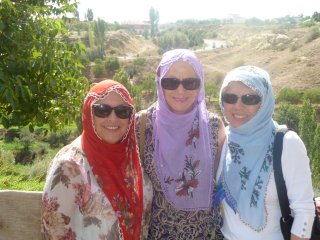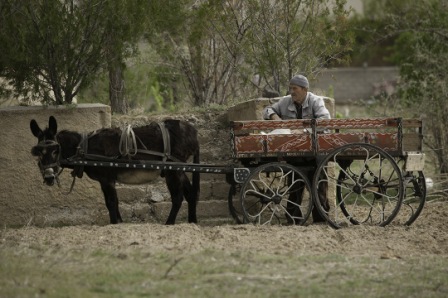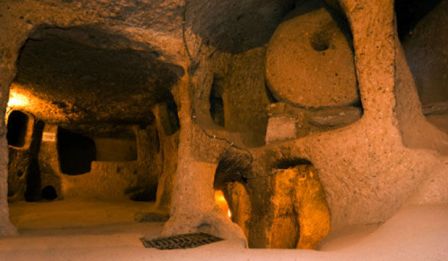|
11 September, 2014
THURSDAY |
|
Click here
|
|
|
|
Later start brought smiles to the breakfast room. The group has truly coalesced. The men seem to have softened amid all the estrogen. We visited Meli's friend Fatima and her husband Hussein in their home which is partially carved inside the mountain. Before arriving, we learned three Turkish words: çok güzel (chock goozel): very nice/beautiful günaydın (gew-nahy-DUHN): good day sağ ol (sa-ol): thank you The farm machinery was painted with bright colors, which Meli explained was a manifestation of the Turkish people's love of beautifying everything around them. Fatima walked down the road to greet us. Big beautiful smile that originated in her eyes and spread down to her mouth. She wore her scarf in the Cappadocian style. We sat in her living room which had couches arranged in a U shape. The floors and walls were covered with carpets, one of which was her dowry carpet. The room had electricity and, much to our surprise, a large flat screen TV (initially covered with a blanket). Their home is now a national monument so that they can live there and pass it to their children but they cannot sell it. There is a 4th century church in the same area. Hussein joined us. He had baked a delicious cake for us which he served with tea. He is about 72 and retired from being a truck driver and holding a position with the municipality. He has a picture of himself on the wall that he pointed to with huge amount of pride. They have 2 children and 5 grandchildren. Family is very important. Lack of jobs resulted in their eldest son going to Denmark for 15 years. Fatima and Hussein could not visit when their first grandchild was born so their son decided to return home. We learned about the various ways that women wear and tie their scarves according to the region where they live. Fatima does scarf tatting and offered us an opportunity to buy her scarves along with dolls, crotchet items, pillow cases, and jewelry. Next, we went to lunch at a home in the small village of Ayvali with our hosts Havva and Tugva. The home was also in rock, covered with carpets, and the food was a gastronomic delight. With full and round bellies we went to one of 36 underground cities. Not a place for the claustrophobic! Narrow tunnels to navigate and narrow steps to climb. We had an introduction given to us by a local elder who remembers playing in it as a child before it was opened for tourism. The underground cities were used, in part, by the Christians to avoid persecution by the Romans. The entrances were far from the actual city to avoid detection. No fires or light except in the kitchen. The city would house 1500 people for anywhere from 3 days to a month. We ended the day with a trip to a carpet cooperative. Moustaff guided us through the process beginning with the wool-on-wool and wool-on-cotton carpets. All are done by hand by women who must be at least 18 years old to work at the cooperative. They sit on a pillow just above the ground and work for about 20 or 30 minutes at a time and then take a break. All weaving is done by women. It takes about 5 months to complete the carpet and each one is done from beginning to end by the same woman; the designs are taken from the tiles. The Turks have been weaving carpets for 2600 years. The oldest carpet was found frozen in ice in the Bering Strait. Most of the women learn the art as a girl at home. They join the cooperative because it provides the business structure to sell the carpets. All the sales are done by men. We also saw the weaving of the silk carpets and the process for getting the silk strands. Silk is stronger than steel. Genghis Khan wore silk robes not only because they were light and made movement easier, but also because arrows could not penetrate them. The silk spinning is always done by men. Seem to be job divisions based on sex. I asked Moustaff if the women who did the weaving were paid the same as the men and he said "no": the women are the artists and are paid more!
|
||





Gul Borek

Recipe FOR THE DAY
gul
borek :
ingredients: 4 sheets of
phlox, 2 pounds of minced beef ( no fat at all - very lean) 2 onions
grated, black pepper, one cup of sun flower oil, one cup of whole milk,
2 eggs, sesame seeds
How to prepare gul
borek at homE
- In a pan, add the onions and meat. Stir them constantly until onion and meat changes color, add 2 spoons full of water and boil it until there is no juice left. Add salt and black pepper. While the meat is still hot grate one potato in the meat.
- Set this aside with a lid on the pan. Let it simmer while you are preparing the dough.
- In a bowl mix sun flower oil and water
- Put the phi lox dough on the kitchen counter. Open it flat. put the mixture of water and milk on the dough generously.
- Cut the dough in 4 pieces. Put the meat that you have prepared on the dough. One big spoon full meat for each piece of dough. Roll the dough then make little roses out of it and to keep the ends from opening put the milk water solution on the ends. Put the little "roses" in a baking pan. Squeeze them together.
- mix the yoke of the eggs in a bowl and add 2 table spoon of oil. mix them all together.
- put this mixture on the little roses
- Make sure your oven is pre heated 350 f - 400 F
- Cook for 25 minutes
How to Serve
Put butter in a pan. Let it
melt and sizzle. Add paprika and pinch of salt. Serve the " borek" put
garlic yogurt on it and add a small spoon of butter.
Click here
for Day 07 KONYA
melitour home page
turkey 101 itinerary


